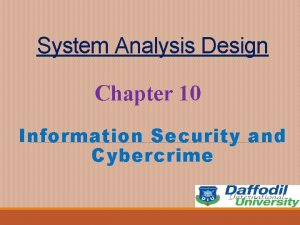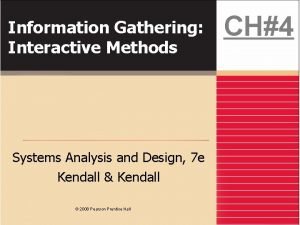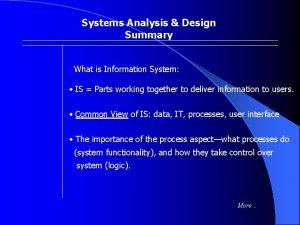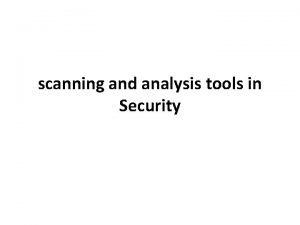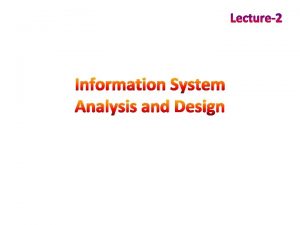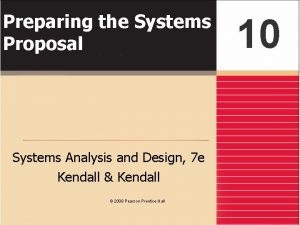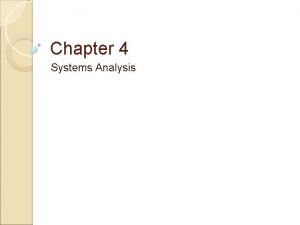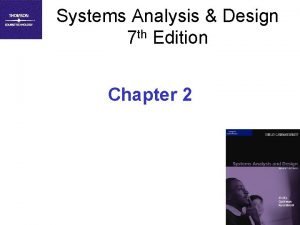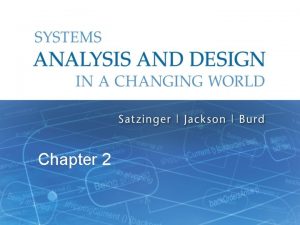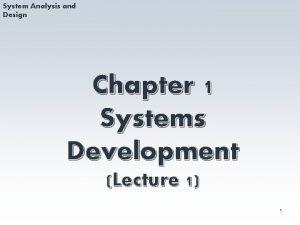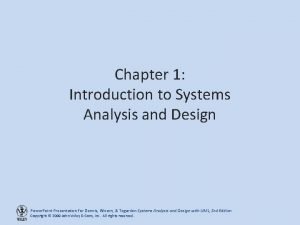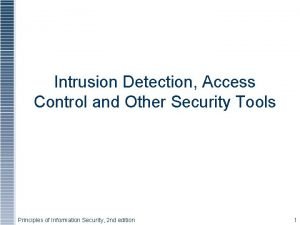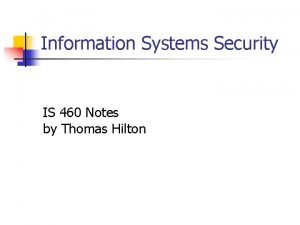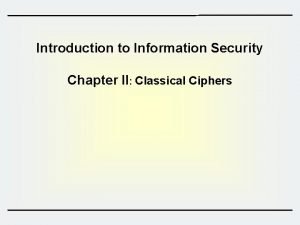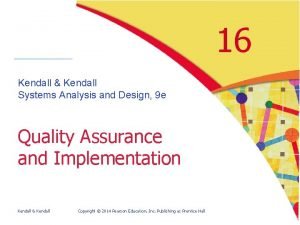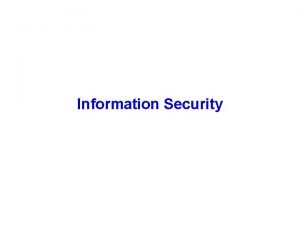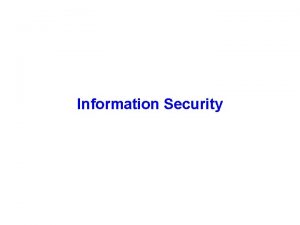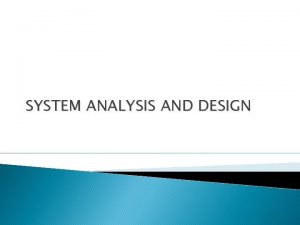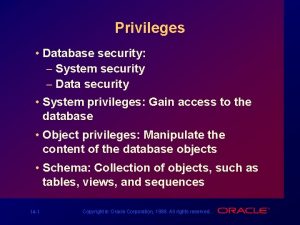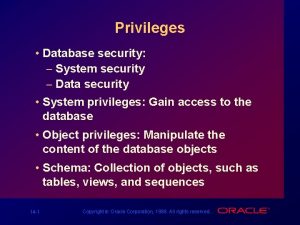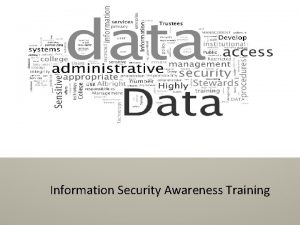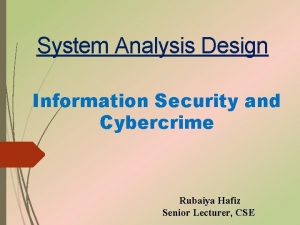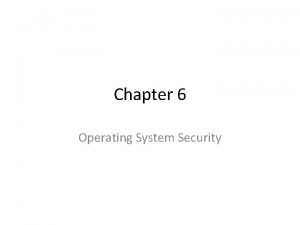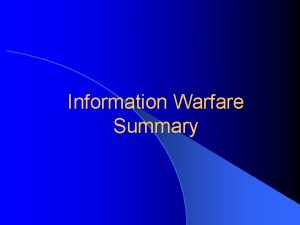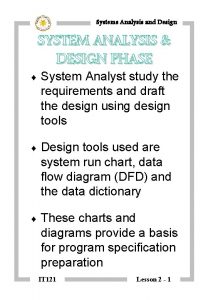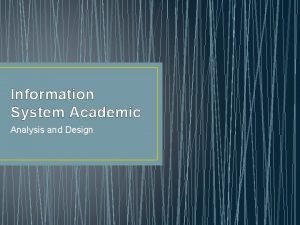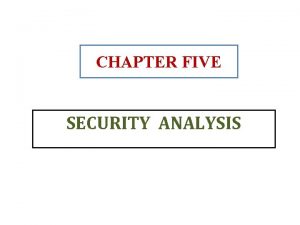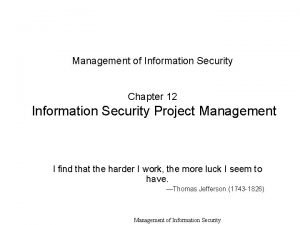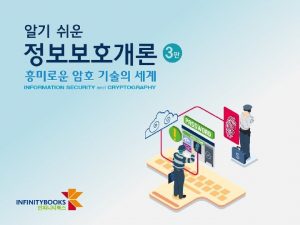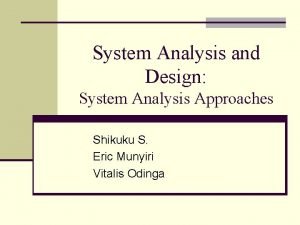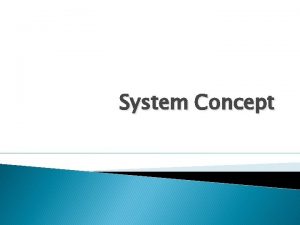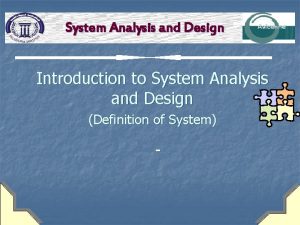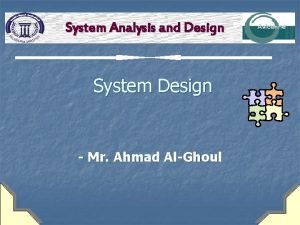System Analysis Design Chapter 10 Information Security and





























- Slides: 29

System Analysis Design Chapter 10 Information Security and Cybercrime

Computer Applications in the Society Ø Education/Research Ø Government Ø Finance Ø Science Ø Healthcare Ø Enterprise Ø Publishing Ø Travel Ø Industry Ø Personal Communication

Internet-based Applications in the Society v Emailv Social media v Messenger –

Security Challenges and Vulnerabilities

Malware (malicious software) q Viruses u Rogue software program that attaches itself to other software programs or data files in order to be executed q Worms u Independent computer programs that copy themselves from one computer to other computers over a network. q Trojan horses u Software program that appears to be benign but then does something other than expected.

Malware (malicious software) q SQL injection attacks u Hackers submit data to Web forms that exploits site’s unprotected software and sends rogue SQL query to database q Spyware u Small programs install themselves surreptitiously on computers to monitor user Web surfing activity and serve up advertising q Key loggers u Record every keystroke on computer to steal serial numbers, passwords, launch Internet attacks

Hackers and Computer Crime Hackers vs. crackers • System intrusion • System damage • Cyber vandalism: Intentional disruption, defacement, destruction of Web site or corporate information system 7

Computer Crime q Spoofing q Misrepresenting oneself by using fake e-mail addresses or masquerading as someone else q Redirecting Web link to address different from intended one, with site masquerading as intended destination q Sniffer q Eavesdropping program that monitors information traveling over network q Enables hackers to steal proprietary information such as e-mail, company files, etc.

Computer Crime v Denial-of-service attacks (Do. S) • Flooding server with thousands of false requests to crash the network. v Distributed denial-of-service attacks (DDo. S) • Use of numerous computers to launch a Do. S

q Do. S utilizes a single connection, while a DDo. S attack utilizes many sources of attack traffic

Computer Crime q Defined as “any violations of criminal law that involve a knowledge of computer technology for their perpetration, investigation, or prosecution” q Computer may be target of crime, e. g. : u Breaching confidentiality of protected computerized data u Accessing a computer system without authority q Computer may be instrument of crime, e. g. : u Theft of trade secrets u Using e-mail for threats or harassment

Computer Crime q Identity theft • Theft of personal Information (social security id, driver’s license or credit card numbers) to impersonate someone else q Phishing • Setting up fake Web sites or sending e-mail messages that look like legitimate businesses to ask users for confidential personal data. q Evil twins • Wireless networks that pretend to offer trustworthy Wi-Fi connections to the Internet

Computer Crime q Pharming • Redirects users to a bogus Web page, even when individual types correct Web page address into his or her browser q Click fraud • Occurs when individual or computer program fraudulently clicks on online ad without any intention of learning more about the advertiser or making a purchase q Cyber terrorism and Cyber warfare

Proof of Computer Crime q Electronic evidence • Evidence for white collar crimes often in digital form u Data on computers, e-mail, instant messages, ecommerce transactions • Proper control of data can save time and money when responding to legal discovery request q Computer forensics: • Scientific collection, examination, authentication, preservation, and analysis of data from computer storage media for use as evidence in court of law • Includes recovery of ambient and hidden data

What are Cyber Crime? Improperly accessing a computer, system, or network; u Modifying, damaging, using, disclosing, copying, or taking programs or data; u Introducing a virus or other contaminant into a computer system; u Interfering with someone else's computer access or use; u Falsifying email source information; and u Stealing an information service from a provider. u

What are Cyber Crime? q Offences against computer data and systems q Misuse of computer devices q Computer-related forgery q Computer-related fraud q Child Pornography q Offences related to infringements of copyright and related rights

Hacker Targets u Financial data Intellectual Property u Personal data u u System Access u Theft, modification or sale, blackmail Theft, sale, personal gain u Modification, sale u Sabotage, backdoors, exploitation u

What the Law of Bangladesh Says? q If a person intentionally causes loss or damage to any other person or organization by any act which destroys, deletes or alters any information residing in a computer resource or diminishes its value or affects it by any means, would be considered to have engaged in hacking.

Information Security v Security: Policies, procedures and technical measures used to prevent unauthorized access, alteration, theft, or physical damage to information systems: v. Physical Security v. Network Security v. Data Security

What Is Network Security? q "Network security" refers to any activity designed to protect the usability and integrity of your network and data. It includes both hardware and software technologies. Effective network security manages access to the network. It targets a variety of threats and stops them from entering or spreading on your network.

Types of network security q q q q Access control Antivirus and antimalware software Application security Data loss prevention Email security Mobile device security Security information and event management

What is data security? q Data security concerns the protection of data from accidental or intentional but unauthorized modification, destruction or disclosure through the use of physical security, administrative controls, logical controls, and other safeguards to limit accessibility.

Technologies and Tools for Protecting Information Resources u Firewall: • Combination of hardware and software that prevents unauthorized users from accessing private networks • Technologies include: u. Static packet filtering u. Network address translation (NAT) u. Application proxy filtering

Technologies and Tools for Protecting Information Resources u Intrusion detection systems: • Monitor hot spots on corporate networks to detect and deter intruders • Examines events as they are happening to discover attacks in progress u Antivirus and antispyware software: • Checks computers for presence of malware and can often eliminate it as well • Require continual updating u Unified threat management (UTM) systems

Technologies and Tools for Protecting Information Resources u Securing wireless networks -Continually changing keys -Encrypted authentication system with central server

Technologies and Tools for Protecting Information Resources u Encryption: • Transforming text or data into cipher text that cannot be read by unintended recipients

Technologies and Tools for Protecting Information Resources u Digital certificate: § Data file used to establish the identity of users and electronic assets for protection of online transactions § Uses a trusted third party, certification authority (CA), to validate a user’s identity § CA verifies user’s identity, stores information in CA server, which generates encrypted digital certificate containing owner ID information and copy of owner’s public key

Safe and Ethical Uses of Computers q Ethics • Principles of right and wrong that individuals, acting as free moral agents, use to make choices to guide their behaviors q Professional codes of conduct • Promulgated by associations of professionals u E. g. AMA, ABA, AITP, ACM • Promises by professions to regulate themselves in the general interest of society

Property Rights: Intellectual Property q. Trade secret: Intellectual work or product belonging to business, not in the public domain. q. Copyright: Statutory grant protecting intellectual property from being copied for the life of the author, plus 70 years. q. Patents: Grants creator of invention an exclusive monopoly on ideas behind invention for 20 years
 System security in system analysis and design
System security in system analysis and design Privatesecurity
Privatesecurity User interface input and output design
User interface input and output design Interactive methods of information gathering
Interactive methods of information gathering What is information system analysis and design
What is information system analysis and design Visa international security model
Visa international security model Cnss model
Cnss model User interface design in system analysis and design
User interface design in system analysis and design Dialogue design in system analysis and design
Dialogue design in system analysis and design Structured analysis definition
Structured analysis definition Fact finding in system analysis and design
Fact finding in system analysis and design Feasibility
Feasibility Scanning and analysis tools in information security
Scanning and analysis tools in information security Nine characteristics of system
Nine characteristics of system System proposal in system analysis and design
System proposal in system analysis and design Objectives of system analysis
Objectives of system analysis System analysis and design chapter 2
System analysis and design chapter 2 System analysis and design chapter 2
System analysis and design chapter 2 System analysis and design chapter 1
System analysis and design chapter 1 System analysis and design chapter 1
System analysis and design chapter 1 Chapter 9 information management and security
Chapter 9 information management and security Padded cell system in information security
Padded cell system in information security Information system security notes
Information system security notes Scytale
Scytale Kendall and kendall system analysis and design
Kendall and kendall system analysis and design Determining human information requirements
Determining human information requirements Patched up prototype
Patched up prototype Kendall system analysis and design
Kendall system analysis and design Systems analysis and design kendall
Systems analysis and design kendall Wireless security in cryptography and network security
Wireless security in cryptography and network security
